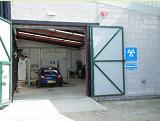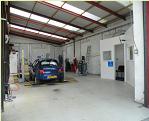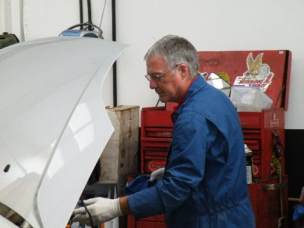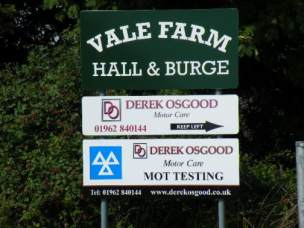If you want to see larger or smaller text,
press Ctrl & +/- keys,
or Ctrl & mousewheel.





[ Winchester MOTs ]

[ click photos to enlarge ]
MOT tests in Winchester, Hampshire ... with free courtesy car.
MOT tests can be carried out on your car up to one month before the expiry date of an existing UK MOT certificate provided that a current MOT certificate is presented to the examiner at the time of the test.
On passing the MOT test, the vehicle will receive a new certificate valid from the date of expiry of your existing MOT certificate.
MOT test fees are not subject to VAT.
VT20 MOT Test Certificate:
This certificate confirms that at the time of the test, without dismantling it, the vehicle met the minimum acceptable environmental and road safety standards required by law. It does not mean that the vehicle is roadworthy for the length of time the certificate is valid. The MOT certificate is also no guarantee of the general mechanical condition of your vehicle.
The test does not cover the condition of the engine, clutch or gearbox.
MOT tests:
The MOT looks at some important items on your car to see that they meet key legal requirements at the time of test.
Driving Controls
Steering Wheel and Column
Footbrake and Servo
Handbrake
Light Switches and Horn
Windscreen Wipers and Washers
Exterior
Suspension
Shock Absorber Effectiveness
Tyres and Wheels
Body Condition
Lights
Sidelamps
Direction Indicators
Headlamps
Headlamp Aim
Reflectors
Stop Lamps
Rear Lamps
Fog Lamps
Under Bonnet
Braking Components
Suspension
Steering
Under Vehicle
Steering
Tyres and Wheels
Foot and Handbrake System
Suspension and Shock Absorbers
Wheel Bearings and Driveshafts
Exhaust
Chassis
Brake Performance
Footbrake Efficiency
Front Brake Balance
Handbrake Efficiency
Exhaust Emission
Carbon Monoxide (CO) Emission
Hydrocarbon (HC) Emission
Lambda
Excessive Visible Smoke
The following section is designed to give you an indication as to what items are tested during an MOT and how this is done. This list is only a brief summary of the actual procedures used and not all items apply to all cars. It should also be noted that dis-assembly of any part of the vehicle is not allowed during an MOT test, which means that hidden items such as faulty wheel cylinders cannot be seen or failed.
Body & Vehicle Structure - is free from excessive corrosion or damage in specific areas and there are no sharp edges likely to cause injury.
Fuel System - has no leaks and the fuel cap fastens and seals securely. The fuel cap will need to be opened so be sure the key is available.
Exhaust Emissions - the vehicle meets the requirements for exhaust emissions, dependant on the age and fuel type of the vehicle.
Exhaust system - is secure, complete, without serious leaks and silences effectively.
Seat Belts - all belts installed are checked for type, condition, operation and security. All compulsory seat belts must be in place.
Seats - the front seats are secure. Front and rear backseats can be secured in the upright position.
Doors - latch securely in closed position. Front doors should open from inside and outside the vehicle. Rear doors may need to be opened to gain access to testable items.
Mirrors - the minimum numbers are on the vehicle, their condition and security.
Load security - boot or tailgate can be secured in the closed position.
Brakes - their condition, operation and performance (efficiency test). Note the removal of the road wheels is not part of the test.
Tyres & Wheels - their condition, security, size, type and tread depth. Spare tyres are not inspected.
Registration Plates - their condition, security, characters correctly formed and spaced.
Lights - their condition, operation and security. Headlamps for aim.
Bonnet - securely 'latches' in the closed position.
Wipers & Washers - operate to give the driver a clear view ahead.
Windscreen - its condition and the driverís view of the road.
Horn - operates correctly and is of a suitable type.
Steering & Suspension - are of a satisfactory condition and operation.
Vehicle Identification Number (VIN) - is on vehicles first used on or after 1 August 1980. Not more than one different VIN is displayed except on multi-stage build vehicles.
MOT tests can be carried out on your car up to one month before the expiry date of an existing UK MOT certificate provided that a current MOT certificate is presented to the examiner at the time of the test.
On passing the MOT test, the vehicle will receive a new certificate valid from the date of expiry of your existing MOT certificate.
MOT test fees are not subject to VAT.
VT20 MOT Test Certificate:
This certificate confirms that at the time of the test, without dismantling it, the vehicle met the minimum acceptable environmental and road safety standards required by law. It does not mean that the vehicle is roadworthy for the length of time the certificate is valid. The MOT certificate is also no guarantee of the general mechanical condition of your vehicle.
The test does not cover the condition of the engine, clutch or gearbox.
MOT tests:
The MOT looks at some important items on your car to see that they meet key legal requirements at the time of test.
Driving Controls
Steering Wheel and Column
Footbrake and Servo
Handbrake
Light Switches and Horn
Windscreen Wipers and Washers
Exterior
Suspension
Shock Absorber Effectiveness
Tyres and Wheels
Body Condition
Lights
Sidelamps
Direction Indicators
Headlamps
Headlamp Aim
Reflectors
Stop Lamps
Rear Lamps
Fog Lamps
Under Bonnet
Braking Components
Suspension
Steering
Under Vehicle
Steering
Tyres and Wheels
Foot and Handbrake System
Suspension and Shock Absorbers
Wheel Bearings and Driveshafts
Exhaust
Chassis
Brake Performance
Footbrake Efficiency
Front Brake Balance
Handbrake Efficiency
Exhaust Emission
Carbon Monoxide (CO) Emission
Hydrocarbon (HC) Emission
Lambda
Excessive Visible Smoke
The following section is designed to give you an indication as to what items are tested during an MOT and how this is done. This list is only a brief summary of the actual procedures used and not all items apply to all cars. It should also be noted that dis-assembly of any part of the vehicle is not allowed during an MOT test, which means that hidden items such as faulty wheel cylinders cannot be seen or failed.
Body & Vehicle Structure - is free from excessive corrosion or damage in specific areas and there are no sharp edges likely to cause injury.
Fuel System - has no leaks and the fuel cap fastens and seals securely. The fuel cap will need to be opened so be sure the key is available.
Exhaust Emissions - the vehicle meets the requirements for exhaust emissions, dependant on the age and fuel type of the vehicle.
Exhaust system - is secure, complete, without serious leaks and silences effectively.
Seat Belts - all belts installed are checked for type, condition, operation and security. All compulsory seat belts must be in place.
Seats - the front seats are secure. Front and rear backseats can be secured in the upright position.
Doors - latch securely in closed position. Front doors should open from inside and outside the vehicle. Rear doors may need to be opened to gain access to testable items.
Mirrors - the minimum numbers are on the vehicle, their condition and security.
Load security - boot or tailgate can be secured in the closed position.
Brakes - their condition, operation and performance (efficiency test). Note the removal of the road wheels is not part of the test.
Tyres & Wheels - their condition, security, size, type and tread depth. Spare tyres are not inspected.
Registration Plates - their condition, security, characters correctly formed and spaced.
Lights - their condition, operation and security. Headlamps for aim.
Bonnet - securely 'latches' in the closed position.
Wipers & Washers - operate to give the driver a clear view ahead.
Windscreen - its condition and the driverís view of the road.
Horn - operates correctly and is of a suitable type.
Steering & Suspension - are of a satisfactory condition and operation.
Vehicle Identification Number (VIN) - is on vehicles first used on or after 1 August 1980. Not more than one different VIN is displayed except on multi-stage build vehicles.
Opening hours:
8am - 5pm
Mon - Fri
8am - 5pm
Mon - Fri
[ MOTs ]
LIGHTING EQUIPMENT
All lights are tested for OPERATION, CONDITION & SECURITY.
SIDELIGHTS and HEADLIGHTS are of the correct type.
Are correctly aimed (headlights).
Operate dip & full beam (headlights).
STOP LIGHTS, INDICATORS & HAZARD LIGHTS are of the correct type.
Do not interact with each other's operation.
Indicator tell-tale or audible warning works.
REAR FOG LIGHTS.
Must be fitted to the centre or offside of the vehicle.
Tell-tale must work.
Must not interact with other lights.
Must not be obscured.
Must be red.
NUMBER PLATE LIGHTS.
All original lights must be present and working.
REAR REFLECTORS.
Two reflectors must be fitted fairly symmetrically be secure and not obscured.
Notes:
Stop lights,indicators and hazard lights must be fitted to vehicles used on or after 1st April 1986, but if fitted must be tested.
Rear foglights must be fitted to all vehicles used on or after 1st April 1980.
ENGINE
CHECKS UNDER THE BONNET.
Upper Suspension Joints and any other suspension
components which can be inspected from under the bonnet.
Security of steering rack or box and mountings.
Excessive play in steering rack or box.
Play in steering joints.
Any other parts of the steering system that can be seen from under the bonnet.
CHECKS UNDER THE VEHICLE.
Front & Rear Suspension.
No split pins, nuts etc missing.
No bent or broken components.
Condition of road springs.
Condition of suspension joints for excessive play etc.
Shock absorbers for leakage & security.
Shock absorbers for damping action.
Excessive play in rack/steering joints under load test
Excessive lift/play in steering box.
Power steering for leaks etc.
Security of Rack/Box and mounting areas for corrosion or cracking.
Wheels an tyres for fouling vehicle body/hoses etc on lock to lock.
Condition of front and rear wheel bearings regarding play and noise.
Steering rack gaiters for splits, leakage, security etc.
Front outer C V boots for splits, leakage, security etc.
Metal/Rubber bushes for excess play or wear.
Locking or retaining devices.
Front drive shafts and C V joints (if applicable).
STEERING
STEERING INSIDE THE CAR.
Steering wheel in good condition.
Steering wheel securely attached to column.
Upper column bearings/bush for excess play.
Steering column for excess end float.
Clamping bolts checked for security.
Locking nuts and split pins.
Free play in steering.
Flexible couplings/universal joints for excess play.
BRAKES
INSIDE THE CAR.
Antilock brake warning light (if fitted), is checked for operation and correct operating sequence
Reserve travel on footbrake so that it does not reach the floor.
Excess wear of brake pedal rubber.
Correct operation of brake servo.
Parking brake for reserve travel so that it does not reach it's end stop.
Parking brake mountings for corrosion and security.
UNDER THE BONNET.
Master cylinder/servo checked for leaks under load.
Servo unit for correct operation.
Visible metal brake pipes for damage, corrosion, leakage or breakages.
UNDER THE VEHICLE.
With load applied to footbrake.
All visible metal brake pipes for condition and corrosion.
Brake discs and drums checked for external condition and contamination.
Security and condition of backplates and caliper mounting devices.
Condition of brake pads (if visible).
Condition and operation of handbrake linkages and cables.
Leaks from brake compensator (if fitted).
BRAKE PERFORMANCE CHECK.
The efficiency and balance of the front and rear brakes using a rolling road.
TYRES
TYRE CONDITION.
The reason for failure with respect to tyre wear is:
"The grooves of the tread pattern are not at least 1.6mm throughout a continuous band comprising:
The central three-quarters of the breadth of tread around the entire outer circumference of the tyre".
Tyres on any axle must be matched with regard to type, size and structure.
Also general condition of tyres, condition of valves serious cuts, bulges or other damage.
WHEEL CONDITION.
Damage, distortion, cracks, distorted bead rim securely attached to vehicle, missing wheel nuts or studs.
The security of any externally fitted spare wheel or spare wheel carrier.
EXHAUST SYSTEM.
Part of the system missing will result in failure.
Excessive deterioration.
Support mountings are missing or broken.
Excessive noise.
EXHAUST EMISSIONS.
This check is carried out using special equipment: The exact details will depend on the age and model of the vehicle.
Excessive smoke (visual check).
Diesel smoke is tested using a smoke meter.
FUEL SYSTEM.
Any fuel leak or defect which will allow fuel to leak out will fail the test.
Fuel filler cap must fasten securely and seal must be in place and in good condition.
GENERAL.
BODY CONDITION AND SECURITY.
The body must not be so insecure or displaced that it could cause the loss of control of the vehicle when driven or cause a danger to other road users.
CORROSION.
Corrosion is a complicated and wide ranging topic.
It can be used as a reason for failure in many of the previous sections.
A brief explanation follows:
A vehicle will fail for excessive corrosion in a 'prescribed area' ie within 30cms of various components such as brakes, steering, suspension, seat belt mounts etc.
Also excessive corrosion not in a 'prescribed area' which is likely to adversely affect the vehicles steering or brakes.
Excessive corrosion can mean a hole or significantly weakened structure.
WINDSCREEN.
Chips or cracks in the windscreen directly in front of the driver, in the area swept by the wiper blades, are acceptable if they are less than 10mm in diameter.
In the rest of the swept area up to 40mm damage is acceptable.
Official stickers (parking permits, tax disc etc) in the swept area in front of the driver will fail if they are more than 10mm in diameter (40mm elsewhere).
WASHERS AND WIPERS.
Operation.
Extent of area swept by wipers.
Condition of wiper blades.
HORN.
Operation.
Control is easily reached by driver.
Loud enough.
Cannot be multi-tone sequential type.
SEATS.
The front seats must be secure.
All seat backs must be securable in the upright position.
SEATBELTS.
Most vehicles after 1965 must have seatbelts:
Irrespective of this requirement all seat belts fitted to a vehicle are inspected for:
Security of seatbelt mountings and locking stalks.
Security and operation of locking/release mechanism.
Condition of webbing.
Operation of retraction mechanism.
Note: The inertia locking mechanism is not checked
On some vehicles where the belt is attached to the seat the security of the seat to the vehicle would also be part of the seat belt check.
With regard to the retraction mechanism it is allowed to manually feed the belt back in.
MIRRORS.
Not all mirrors on all vehicles are subject to the test. This depends on the age of the vehicle but those which are must be:
- Secure.
- Visible from the drivers seat.
- Not distorted or damaged so as to seriously impair the driver's view of the rear.
REGISTRATION PLATES & VIN NUMBERS.
For any registered vehicle number plates must be:
- Present.
- Secure.
- Not faded dirty or obscured.
- Be composed of correctly formed letters, correctly spaced.
VIN plates are required on all vehicles firstly used on or after 1st August 1980 and must be:
- Permanently displayed.
- Consistent.
- Legible.
The MOT service contents and standards required are set by the Vehicle Inspectorate (Vehicle and Operator Services Agency (VOSA)).





